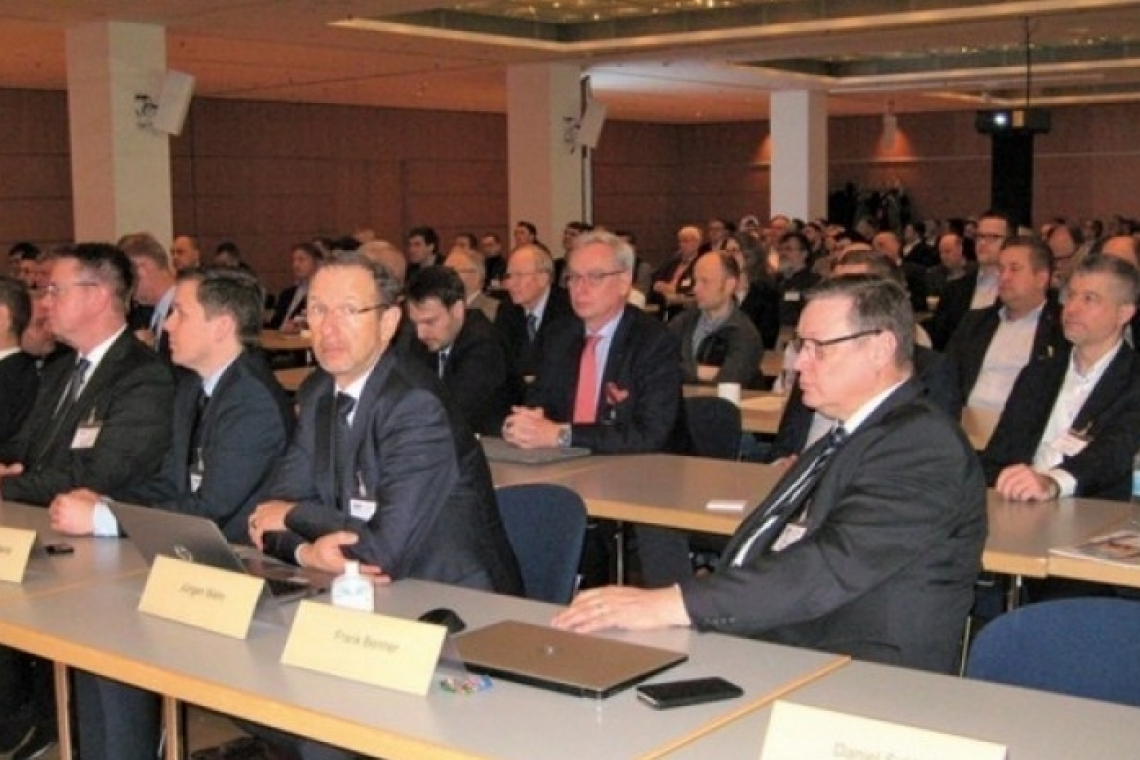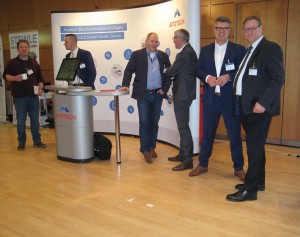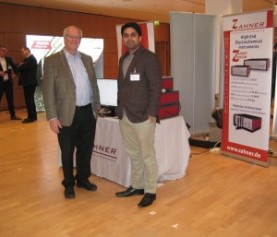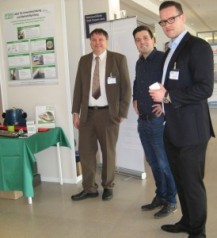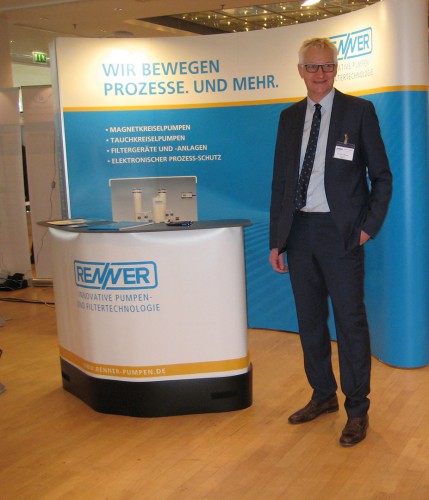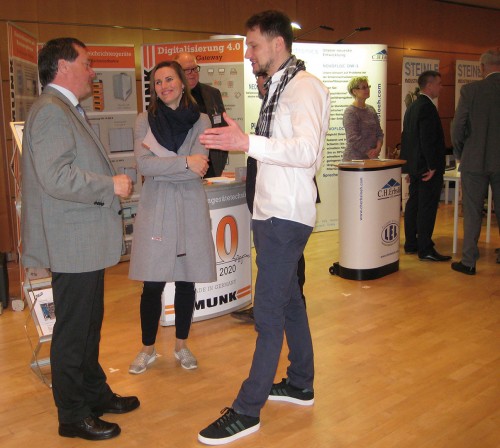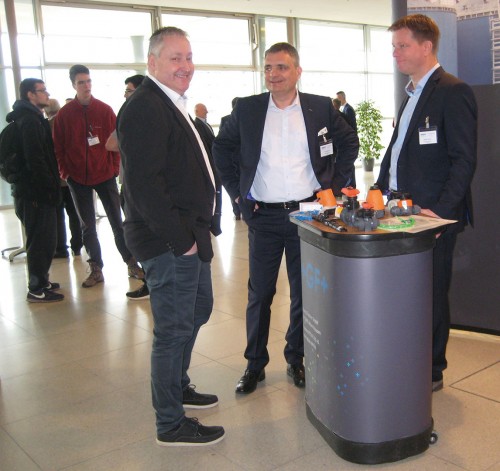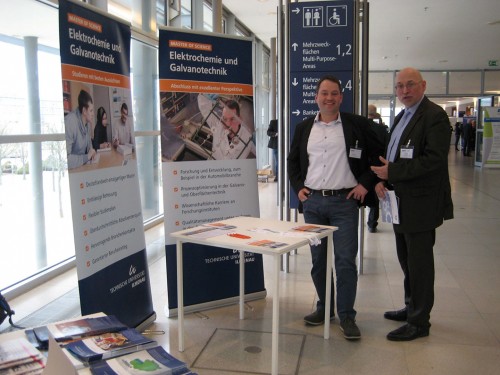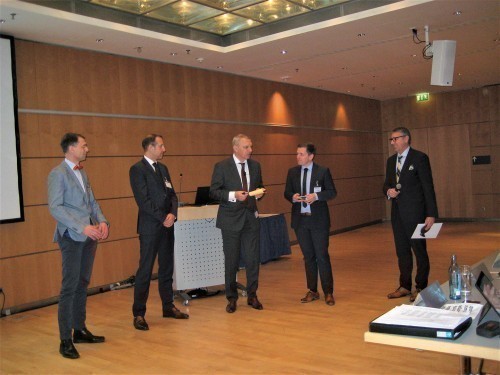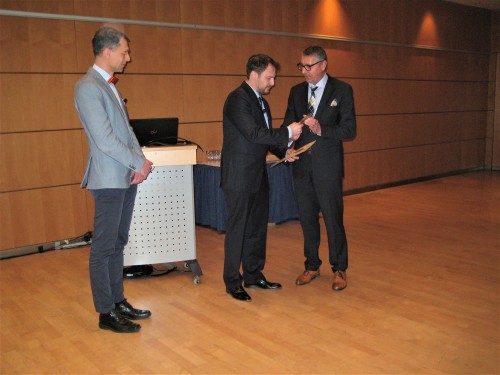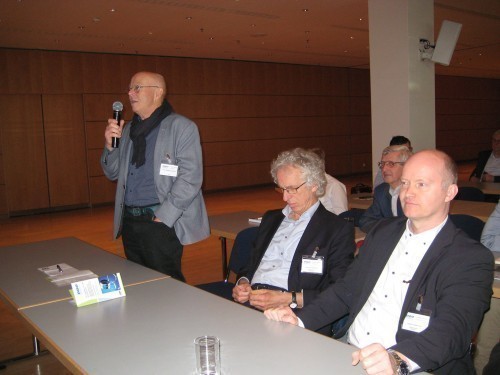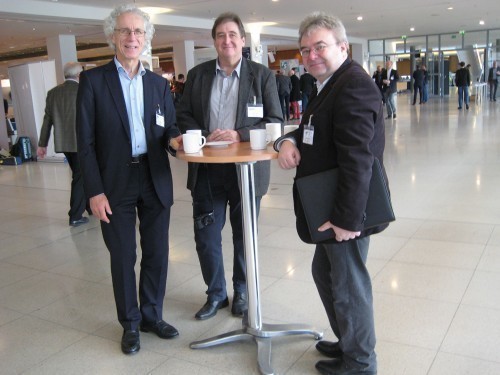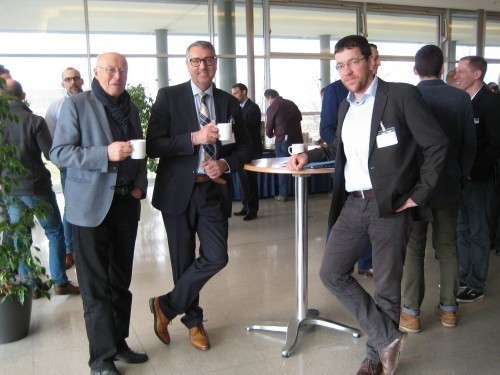249 participants and 55 exhibitors accepted the invitation from the Saxony and Thuringia regional groups to attend the 27th Leipzig Expert Seminar on February 27, 2020. The morning's moderator, Prof. Thomas Lampke, Chemnitz University of Technology, welcomed the new head of the Office for Economic Development of the City of Leipzig, Clemens Schülke, as well as Rainer Venz, Past President of the DGO, Christoph Matheis, Managing Director of the ZVO and representatives of the press. He thanked all exhibitors for their support and the organization team for the selection of the challenging lecture program and for the organization of the event.
Schülke welcomed the participants on behalf of the City of Leipzig and emphasized in his welcoming address that the surface technology sector, as a supplier to the automotive industry, is facing major challenges as a result of structural change. In this context, he provided information about the construction of the Dräxlmair battery plant in the Leipzig area. In future, 800-volt battery systems for a purely electrically powered sports car will be manufactured here. During the event, he wished for a good exchange to master this challenge. Venz, Past President of the DGO for two years since the beginning of 2020, pointed out that Leipzig has achieved a great deal and wished the event every success.
Lampke introduced the auditorium to an organizational innovation: In order to set a highlight later, the Leipzig Electroplating Award will be presented immediately after the lunch break.
However, before the lecture program began, Lampke reminded the audience of the founding of the German Museum of Electroplating e. V. (VDMG e.).V. (VDMG e. V.) ten years ago by Thilo von Vopelius in Leipzig. It was founded with 27 people; today the association has 68 members. The main aim of the association is to interest young people in electroplating technology. To this end, an educational film was produced, a poster and a flyer with all the training opportunities were created and guided tours including the electroplating of samples are offered. He also outlined the main activities of the VDMG e. V. over the last ten years and thanked the Board for its successful development work.
After more than 20 years on the LFS organization team, Jens Heinze, MacDermid Enthone GmbH, will be ending his involvement, which the organization team greatly regrets. Lampke also paid tribute to Heinze's activities as the long-standing head of BG Thüringen, thanked him for his work and, expressly on behalf of the organization team, wished him all the best for the future and expressed the hope that he would continue to remain loyal to the LFS - then as a visitor.
The plenary lecture "Changes in automotive surfaces due to e-mobility" by Rainer Venz, Coventya International GmbH, was extremely exciting and provided some answers to the much-discussed questions in the industry about mastering the challenges arising from the transition to e-mobility.
At the beginning of his presentation, Venz outlined the current state of e-mobility in the world and made it clear that developments in Europe are being driven by punitive tariffs due to demands toreduce CO2 emissions. There are currently various technology concepts for reducing CO2 emissions. For example: biofuel, synthetic fuel, e-vehicles, hybrids, gas, fuel cells and the previous technology with the 1 liter limit, he compared and formulated the advantages and disadvantages of their use. The challenges currently lie in improving the capacity and stability of battery life, minimizing charging times, the infrastructure (charging stations) and, last but not least, customer acceptance.
Venz also outlined the raw material requirements for batteries for electric cars. In first place is water with approx. 4000 km3/a, followed by sand with approx. 40-50 million tons/a. Much further down in the ranking is cobalt. An electric car requires 8-12 kg of Co. The Tesla 3 currently requires 5.5 kg of Co. If we assume that there will be 26.9 million vehicles worldwide in 2025 and further assume that the amount of Co required will be reduced to 50%, then 134,000 tons of cobalt will still be required. This corresponds to 112% of the annual quantity from 2018. Alternative concepts for reducing the valuable raw materials could be hybrid vehicles, the use of fuel cells, but also electric highways, where the electricity is tapped from overhead lines.
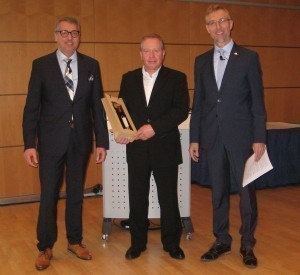 Honoring Jens HeinzeThehistory of electric cars began in the middle of the 19th century. In April 1899, the Belgian Camille Jenatzky reached 105.88 km/h with his electric car. However, this was already the end of the electric car era, as the next speed record was set three years later with a steam car. Why didn't electric cars catch on back then? It was for the same reasons as today: the greater the range, the more power, the larger, heavier and more expensive the batteries. The challenge that manufacturers had to face - then and now: range and charging time.
Honoring Jens HeinzeThehistory of electric cars began in the middle of the 19th century. In April 1899, the Belgian Camille Jenatzky reached 105.88 km/h with his electric car. However, this was already the end of the electric car era, as the next speed record was set three years later with a steam car. Why didn't electric cars catch on back then? It was for the same reasons as today: the greater the range, the more power, the larger, heavier and more expensive the batteries. The challenge that manufacturers had to face - then and now: range and charging time.
Reducing the weight of cars is closely linked to reducingCO2 emissions. The use of aluminum is clearly in the lead here. In 1990, around 50 kg of aluminum was used per vehicle; today it is around 180 kg. Another trend is the use of magnesium, carbon fiber composites and high-strength steel. The use of normal steel is to be reduced to 13% by 2030. Lightweight construction will be a prerequisite for future electric cars.
What consequences will surface technology have to deal with in the wake of e-mobility? There will be changes in the component market, i.e. traditional mechanical components will decline. New components (electronic and electrical components, chargers, electric motors, batteries, connecting elements) will arrive. Demand for traditional mechanical parts will fall, while demand for connectors will rise. Overall, however, there will be significantly more new components than traditional ones will disappear. In terms of coating systems, zinc and zinc alloy coatings will continue to play a major role in the future. Passivation and top coats are subject to requirements in terms of appearance, conductivity and corrosion. More thin layers will be in demand, as well as wear and corrosion protection of the layers. Many requirements have not yet been defined due to the lack of field experience.
In the first presentation in the "Industry 4.0" topic block, Frank Benner, B + T Technologies GmbH, asked "Networked surface technology - how does it work?". 4.0 is about networking several production steps that need to be optimized along the value chain. The technical basis for this are intelligent and digitally networked systems. The question is: how can the processes be linked and how do you get started? As Benner explained, the first step is to take stock of the existing data situation, the processes and the network and to answer the question: what do we have and what do we need? It is also important to define the interfaces where information is required and, of course, the digital implementation (hardware and software).
It must be noted that the requirements are much more complex today. In the past, the customer delivered components for coating and usually received them back after five working days. Today, there is a complex network of customer, planning and production interfaces. A transparent electroplating facility has been created at B + T, where the customer can see at any time which processing stage their component is currently in.
With the help of system communication, a visualized feedback of the performance data of the production systems is provided to the production management, management/controlling. This enables rapid intervention in the event of process overruns or error messages. IT security with virus protection, reliability, back-up and employee training is indispensable in this linking process.
An inline analysis system was also developed in collaboration with B+T K-Alpha GmbH, where the entire coating line is continuously monitored. All analysis devices are networked and data is stored in a cloud. This means that both the user and the specialist company can view all relevant data at any time. Problems can be tackled more quickly and in a more targeted manner by the specialist company's employees.
Industry 4.0: And where are the people?
The company also asked itself the question "What about people?" and conducted an employee survey in two plants (Plant 1 BTO (4.0) and Plant 2 BTT/BTS (4.1)) to determine employee satisfaction. It turned out that satisfaction is higher in plant 2, although the complexity factor (the higher the number of process steps per order) is 17 times higher than in plant 1. 98% of employees are satisfied with the company structure, although the requirements in plant 2 are much more complex. In Plant 1, the figure is only 89%.
Benner concluded his presentation with an outlook for 2020, with the aim of reducing the throughput time for the hardening, surface coating, testing/sorting and logistics processes to three working days and processing SST orders within 12 to 24 hours.
Another important sentence was coined during the discussion on this presentation:
"What is important is the process, a bad process cannot be digitized."
In the following presentation, Heinrich-W. Kämper, Munk GmbH, presented "Intelligent power supply systems for Industry 4.0". First, however, Kämper drew attention to the company's 50th anniversary this year, which means that Munk GmbH has been supplying customized power supply solutions for industrial applications for 50 years.
To be suitable for 4.0, the rectifiers must meet the following requirements:
- Networking via common bus systems
- Reliability (use as few safe components as possible, safe technology)
- Energy efficiency (what makes sense, power factor causes costs)
Efficiency and reliability are determined by the design of the components. A generous design ensures high efficiency and high reliability.
This is where the Munk Area Network (MAN) concept with the Munk Gateway MAN rectifier device comes in; the key to greater safety and productivity. The presence of cyber security management (IT security) is essential. This ensures that the communication channels (cable, radio, third-party compatible) are secure and that networks, computer systems, data, etc. are protected.
The Munk gateway supports the identification of the rectifier device. This means that it automatically recognizes the type and nominal data of the rectifier and forwards the data to the higher-level control system. Additional mobile operating devices (tablet) and stationary operating devices (touch panel) can be connected. The Munk gateway supports the operator in the verification of setpoint/actual value deviations through warning messages when limit values are exceeded or not reached. The device has a hot-plug function, which eliminates the administrative work involved in installation and device replacement, as well as parallel switching functionality (parallel connection of rectifier devices).
Kämper explained that further development work is underway. These are the prospects for the future:
- Recognition of ambient parameters (such as cooling water inlet and outlet temperatures, exhaust air temperature, cooling air temperature)
- Internal fault detection and logging
- Intelligent response to process requirements (gateway makes independent decisions on how to respond to changes)
- Better planning of maintenance intervals (e.g. logging the switching frequency of contactors)
Daniel Schlak, Deutsche Metrohm GmbH & Co KG, then spoke on the topic of "Safe control of chromium(III) electrolytes using automated analysis methods". When using chromium(III) electrolytes, users are faced with the challenge of adhering to the specifications for the concentration of the bath parameters more consistently than with other methods. Schlak demonstrates possibilities for automating the analysis of bath parameters. The advantages of online analysis are generally a high analysis frequency, fast feedback and higher accuracy (e.g. no errors in manual sampling, fixed measurement set-up).
One possibility is the automatic control of the pH value. Online systems continuously monitor the condition of the electrodes and readjust them if necessary (longer service life). Automatic dosing with an accuracy of up to pH 0.5 (or better) enables automatic adjustment of the bath. This ensures round-the-clock availability and complete documentation.
Furthermore, continuous monitoring of the entire process chain is possible by monitoring the rinsing water and fully automatic chromium(III) electrolyte analysis. Different analysis methods are required for the parameters Cr(III), foreign metals, boric acid, pH value, density and conductivity. The required methods such as titrations, photometry, ion chromatography, direct measurements (pH, conductivity, density) etc. can be combined in one system. The determination of the foreign metal content, for example, is measured with an Optrode. The desired wavelength is set automatically and all titrations with color indicators are evaluated reliably and automatically.
The systems are offered in a compact and space-saving modular design with simple operation via touchscreen, flexible control and evaluation as well as simple network integration and process communication. The aim is to minimize malfunctions and make automatic re-dosing functions reliable.
The last presentation in the Industry 4.0 block was given by Michael Hellmut, Softec AG, on the topic of "Why 4.0 already makes sense today - advantages for logistics and process reliability". Before Hellmuth presented specific examples, he pointed out once again that the key prerequisite is to digitize existing analogue processes. And as already stated in the first presentation: A bad analog process leads to a bad digital process. So the first step is to check or revise the analogue process before digitization.
Exhibition impressions
Digitization: possibilities in an electroplating shop
Hellmuth also presented examples of the possibilities for digitalization in electroplating. One possibility is RFID transponders, which are familiar from the retail sector. A transponder is attached to each container and RFID antennas are attached to key positions in the plant. These antennas read the transponders in their environment and transmit the information to an ERP system. Until now, there has been a problem with the use of RFID transponders in electroplating plants: The metal (components to be coated, lattice boxes, shopping baskets) interferes with the transponders' radio connection. For this reason, plastic folders are used so that the radio connection remains undisturbed.
Another option is the use of barcodes. This data is recorded via mobile apps. The RFID system can thus be expanded and refined, making the company's information system ever denser. This means that digitalization does not have to be implemented in a single step. Coating systems should also be part of digitization. Up to now, these have mostly been isolated solutions. With an interface to the ERP system, the systems can be connected in such a way that a direct exchange of information is possible.
The use of artificial intelligence (AI) in production planning is currently an interesting approach. Restrictions must be formulated in the system for the use of AI. This sets a framework in which it simulates possible scenarios. The AI attempts to find optimal solutions.
The aim of the digitalization measures is, among other things, to increase customer and employee satisfaction, reduce set-up times, improve resource utilization and ensure adherence to deadlines. In conclusion, Hellmuth made it clear that there is no defined start and end point and that each company decides for itself how, when and where it enters the digitalization process.
After the lunch break, which was used for a lively exchange of opinions inside and outside the exhibition, Dr. Olaf Boehnke, environmental protection expert, took over the moderation of the afternoon presentations. He began with a passionate appeal to all participants to raise awareness and improve the image of electroplating (both of which are still largely underdeveloped among the general public). This problem has been weighing on the entire industry for many years, which has had a dramatic effect on the training market, among other things.
As already mentioned at the beginning, the Leipzig Electroplating Prize was awarded immediately after the lunch break. According to Dr. Boehnke, six extremely high-quality applications were submitted. In consultation with the organizing team, the jury decided to award 1+1 electroplating prizes this year. The prizes were presented by Past President Rainer Venz and jury spokesman Stefan Kaßner, Nehlsen-BWB Flugzeug-Galvanik Dresden GmbH & Co KG.
Electroplating prize 1: Airbus AG for the 3D-SurFin® technology
Dr. Jürgen Wehr and Dr.-Ing. Tobias Mertens, Airbus AG, presented a double lecture on "3D-SurFin® - A key technology for the additive manufacturing of metal components". Metal additive manufacturing is of great importance for the realization of new lightweight components intended for the aerospace industry. It enables the production of complex geometries (e.g. bionically inspired structures). The problem with the process is that the surface of powder-coated AM components has partially fused particles, a high degree of roughness, an inhomogeneous particle structure and significant waviness. The generally difficult to reproduce surface quality limits the use of such components in the aerospace industry, whereby the unsatisfactory fatigue behavior plays a central role.
To solve this problem, an electrochemical plasma polishing process was presented, which leads to the removal of melted particles and a reduction in roughness with treatment times of up to 60 minutes. This results in a significant improvement in the fatigue behavior of the components. The process has so far been optimized for aerospace components made of titanium. It is part of an entire process chain including pre- and post-treatment. The economic potential of the process lies, among other things, in the weight optimization of 3D-printed components, such as those used in the Ariane 5 rocket.
The process presented, for which a patent application has already been filed, is of course not equally suitable for all components; mechanical and thermal processes are available as alternatives.
Electroplating Prize 2: Politeknik Metal San ve Tic A.S. (Coventya Group) for the Castelox process
Dr. Can Akyil, Coventya Group, reported on special problems and their solutions when anodizing aluminium die-cast parts containing silicon. Following introductory remarks on the anodizing process and the properties of anodized aluminium, the speaker addressed the problem of the different removal rates of silicon and aluminium when anodizing such parts, which leads to uneven oxide growth and thus to their lower corrosion resistance. Previously known additives based on oxalic acid could not remedy this shortcoming or even exacerbated it. The solution is to use a specially adapted organic additive that activates the silicon and thus ensures the homogeneity of the resulting oxide layers. The effect achieved was demonstrated using SEM images of aluminum castings with a Si content of 7 to 12 %. The layers can then be colored.
Filmic impurities
Many applications for which the use of high-alloy aluminium was previously not possible can now be produced in lightweight construction and provided with a functionalized surface.
The process, marketed as "Castelox", was patented in 2019. Information on the structure and details of the specific mode of action of the additive used were not provided.
The lecture program was continued by Dr. Michael Flämmich, Vacom Vakuum Komponenten & Messtechnik GmbH, with the topic "Controlling filmic contamination".
The speaker began by introducing the FiT Fachverband industrielle Teilereinigung e. V., which, with more than 70 members, is the leading network of experts in component cleaning for chemistry and the environment, processes and plant technology as well as measurement, testing and control. The FiT guideline on filmic contamination discussed here was developed in the Measurement, Testing & Control working committee with the aim of qualifying users to be able to implement the entire component cleaning process chain in a quality-assured manner. This process chain includes the initial state before cleaning, the actual cleaning processes, the cleaning chemicals, the measuring, testing and analysis technology as well as process monitoring. The guideline is aimed at operators of parts cleaning systems, those responsible for cleaning processes, users of measuring and testing technology and parts manufacturers. The latter should be encouraged to keep an eye on the cleaning possibilities of their components right from the design and parts production stage.
The guideline was published at parts2clean in October 2018 and has also been available in English since October 2019. It can be purchased from FiT e. V. for 50.00 euros plus VAT (for FiT members for 20.00 euros plus VAT).
Handling substances hazardous to water
Ulrich Mäule, Qubus GmbH, continued with the topic "Ordinance on Installations for Handling Substances Hazardous to Water - AwSV".
As a federal ordinance, the AwSV standardizes the previous 16 state ordinances (known as VAwS).
The basic principle of the AwSV is the prevention of soil and groundwater contamination as a result of leaks and extinguishing water through material and organizational measures. Based on § 62 WHG ("principle of concern, also well known from the Federal Immission Control Act), all fixed or permanently used facilities for the storage, filling, production, treatment and use of substances hazardous to water must be equipped in such a way that there is virtually no likelihood of water pollution. The facilities must therefore be leak-proof, leaks must be detectable and leakage collection facilities must be available. The systems must be installed and maintained by specialist companies and inspected by experts. In addition, a mandatory alarm plan must limit damage.
The AwSV applies to HBV systems (production, treatment, use), LAU systems (storage, filling, handling) and pipeline systems. When classifying facilities, operators must take into account water protection areas and flood plains and determine hazard levels based on the substances present.
Extinguishing water retention
In principle, plant operators must assign their plant to a hazard level. This hazard level depends on the quantity and the respective water hazard class (WGK 1-3) of the substances in the system; mixtures are assessed according to a special "calculation rule". Based on these calculations, the systems are to be classified in hazard levels A-D. Containment facilities must be provided for the relevant substances, the volumes of which depend on the hazard level determined. In level D installations located in water protection and flood areas, it must be possible to collect the total volume of the relevant substances. The inspection intervals by experts for level C and D systems are 5 years.
The plant operators must notify the responsible water authorities of the operation of their plant. The documentation required for this varies from state to state, but is always extensive. Plant operation must now also be documented in accordance with water legislation.
Extinguishing water retention is currently only available as a draft. This topic then sparked a lively discussion in which the proposed volumes were criticized as not being feasible. The moderator noted that the retention volumes required by the
insurance companies are sometimes up to a factor of four higher.

